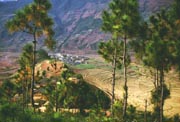Course
Home
Class schedule
E-mail the class
READING
Here's a state of things
Local Ecologies
Grand Histories
Modern Predicaments
What next?
WRITING
Local Ecologies
Grand Histories
Modern Predicaments
What Next?
|
Readings for Unit 5: WHAT NEXT?
For our final Unit, we move away from the national scale we looked at in Unit 4, and go both down to the village, to describe just how the local communities we studied in Unit 3 are faring today, and up to the globe, where we look at China's environmental footprint and at international concerns about biodiversity and conservation.
Tuesday, May 24: Han Chinese Farmers Now
As soon as the Communists took over China in 1949, they began trying various top-down ways of increasing food supply, particularly grain production, which went along with various programs to revolutionize rural society in various ways at different times. Here we will look at the effects on, and reaction by, local communities.
- We can begin with a local account of the Great Leap Forward and ensuing famine that you have been reading about in Shapiro's Mao's War: A Life and Death Struggle from Edward Friedman, Mark Selden, and Paul Pickowicz's Chinese Village, Socialist State.
- Then look at an outstanding (though it's incomplete, as are all web pages produced by amateurs and academics) web-based ethnography of a village in Sichuan, compiled by Pamela Leonard and John Flower. You won't have time to read the whole thing, but try to read the introduction and some of the articles in the "landscape" section.
- In recent years, the New Socialist Countryside Construction Program is if anything an even more comprehensive program to reshape the countryside physically as well as socially. You can read about a few of its effects in
For class today, you will see two more case studies, one that I will present, about and area where we have been working, on the Chengdu Plain, and another tentative one from Ross Doll, who has done research in an experimental area for land consolidation, in Jiangxi. On the basis of these and materials, we will conclude with a discussion of whether recent changes, undertaken in the interests of stability and productivity, increase or decrease resilience of Han ecologies.
Thursday, May 26: Minority Ecologies Now
I wish we had one more class period for this, but think back to the films that you saw on the second day of class, back in March. We'll be taking another look at some minority communities, both in the Upland Zone and in the Pastoral Zone.
- The Upland Zone
Back to the Akha and the Nuosu. Review, if you have time, the last half of Border Landscapes, and listen to me talk about the Ecohistory of the Baiwu Valley in terms relating explicitly to sustainability and resilience. You might also want to look at a comprehensive analysis that Aga Rehamo and I wrote of how ecology, economy, education, and ethnicity fit together in that area, A New Dilemma in China's Borderlands. Most importantly, begin reading Hathaway's Environmental Winds, which pertains to this and the next two class sessions; the review of Hathaway's book is due on Monday, May 30.
- The Pastoral Zone There seems to be a particularly sharp conflict, as James Scott would predict, between pastoralism, with its fluid movements of people and animals across the landscape, and the High Modernist projects of classifying and boxing in. Dee Williams has written provocatively about this conflict in Inner Mongolia; read his Representations of Nature on the Mongolian Steppe.
More recently, Astrid Cerny received her Ph.D. in geography from the UW, for a study of Kazak nomadic pastoralists in Xinjiang as they face various aspects of modernization, globalization, etc. Read a chapter from her dissertation, One Family's Decisions in the Face of Change, and also have a look at The Grassland Law of the PRC.
Finally, no discussion of pastoralism in China would be complete without reference to Tibet. Read about the science and the blame game in R.B. Harris' et al.'s Rangeland responses to pastoralists.
You will notice a certain consistency in these articles. We can talk in class about whether the "blame the government and its pseudo-science" is as facile an explanation as "blame the greedy, ignorant herders."
Tuesday, May 31: Biodiversity, Conservation, and Environmentalism
The problems of biodiversity and conservation are set forth nicely in a general sense by Liu Jianguo's article in Science on Protecting China's Biodiversity. Here we are less interested in the facts than in the way biodiversity and conservation provide a window into Chinese culture and Chinese views of the environment. And since international organizations often have very different attitudes toward conservation, you should read Robert K. Mosely and Renee Mullen's The Nature Conservancy in Shangri-La, as well as having finished Environmental Winds, which you need to have reviewed by last night. There will be plenty to discuss, ranging from Han imperialism to international imperialism to romanticization of local cultures.
Thursday, June 2: China's Global Environmental Footprint
China, like so many economically growing countries in today's world, is no longer self-sufficient in a lot of resources, including wood, minerals, energy, and increasingly food. Today I will give an overview of the ways in which China's growing economy impacts world resources and the environment in other parts of the world. In preparation, you should read Luke Bergman's Bound by Chains of Carbon, as well as Wenran Jiang's Fuelling the Dragon, and David Zweig and Bi Jinhai's China's Global Hunt for Energy.
In class, Professor Luke Bergmann will come for the first hour to talk about his findings on international carbon exchanges, and we will spend the second hour summing up and thinking about the future.
|



